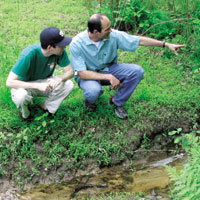Solving the Runoff and Development Mystery
 An occasional leech comes with the territory when you’re studying
leaching and other aspects of stormwater retention, as does the
occasional incident of equipment tampering. At Ironbound, some curious
soul had pulled the cable from its tube.
An occasional leech comes with the territory when you’re studying
leaching and other aspects of stormwater retention, as does the
occasional incident of equipment tampering. At Ironbound, some curious
soul had pulled the cable from its tube.
The 400 retention ponds of James City County might attract casual curiosity, as do the hundreds of thousands like them across the country, but serious study of how well the ponds work has been lacking, until now.
Hancock, associate professor of geology at the College of William & Mary, began serious study in the summer of 2004, starting with two fairly new ponds. Hancock and his Environmental Geology students began “wandering around” the minor waterways of James City County and York County, checking on the health of the usually unnamed and often unnoticed streams that combine to make important watersheds.
Many Ponds, Little Data
“One of the topics in class is how stream systems respond to urbanization. I recognized that there were a lot of hypothetical ideas about how streams and watersheds respond to development, but relatively little data,” Hancock said. “So we started collecting information about how stream flows vary with different types of development.”
The ponds, one at Mulberry Place and another at Ironbound Village, were selected for monitoring. Assisted by Marshall Popkin, an undergraduate who wrote his senior thesis on the ponds, Hancock installed sensors in each pond that record the water level every 15 minutes and store the data in a minicomputer on site. Each pond also has an instrument that records rainfall. Every week or two, Hancock or Popkin or both visit the sites, extract the data and bring it back to the lab. Back in the lab, they compare actual measured data to the predicted model from which the pond was designed.
James City County has adopted regulations more stringent than most localities. Hancock explained that retention ponds built in the county are required to be designed to detain water from the “one-year, 24-hour storm” for 24 hours.
The one-year, 24-hour storm event in James City County amounts to 2.8 inches of rain over 24 hours. In other words, the ponds should be able to accept runoff generated by 2.8 inches of rain falling over the course of a day on the development they serve—then hold it, releasing the water slowly over 24 hours. The standard also means that the ponds can expect to see those 2.8 inches of rain, on average, once a year.
“So we would expect over the course of the year, for instance, to see only once a flow out of these ponds that would be the equivalent of a one-year flow,” Hancock said.
The 2.8 inches can be placed in context by comparison with the 1.5 inches of a normal rainy day on the Peninsula, and by the 5 or 6 inches that came with Hurricane Isabel. “Our gold standard is Hurricane Floyd,” Hancock said. “19 inches in 24 hours.”
Of course, the ponds are built with rainfall of more than 2.8 inches in mind. When an Isabel or a Floyd hits—or even just a really heavy rain—the pond will discharge the excess more quickly. There’s also an emergency spillway built into the dam for safety.
During the months that Hancock and Popkin have been studying the ponds, there have been no Isabels or Floyds, or even a day’s rain equaling the 2.8 inches that the ponds were designed to hold. Yet each of the ponds being monitored performed as if it had been hit by more than 2.8 inches on multiple occasions.
“In actuality we have seen outflows that have exceeded the one-year flow many, many times,” Hancock explained. “At one of our sites, Ironbound Village, we’ve seen the one-year flow ten times. At Mulberry Place we’ve seen it seven or eight times.”
Hancock acknowledges that the performance of these ponds needs more study: he intends to add more ponds (and more undergraduate researchers) to his list. He also will expand the scope of the study to monitoring stream health below the ponds.
He says that so far, results to date back his initial concern about the efficacy of ponds in the area. He’s shared his results with James City County officials and hopes to see his work influence new regulations governing pond design.
“I’m not entirely sure that there is a problem yet, but if there is a problem with how these ponds are working, I’d like to do a couple of things,” he said. “First, figure out what is actually the cause of any design flaws and work with the county to address it. The other thing is, if we find that there’s an issue here, it’s going to be something that’s an issue nationally because these ponds are being designed similarly everywhere.”
 Skip to main content
Skip to main content
